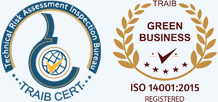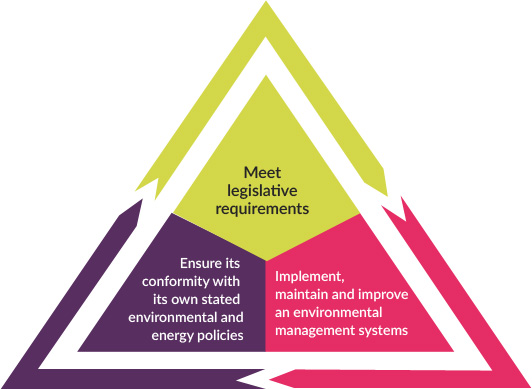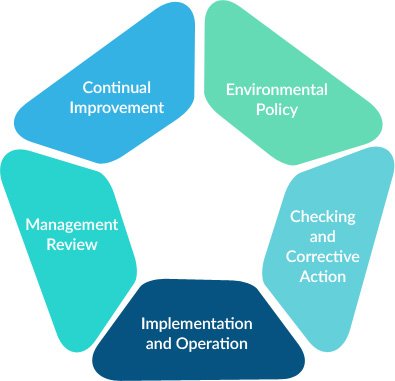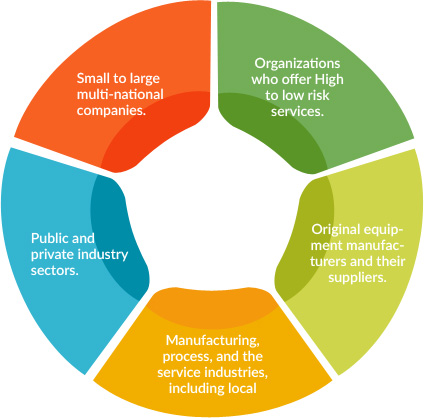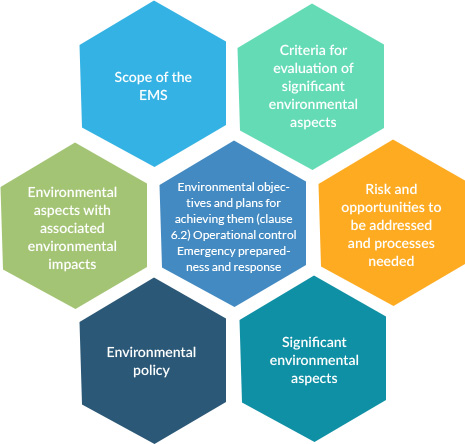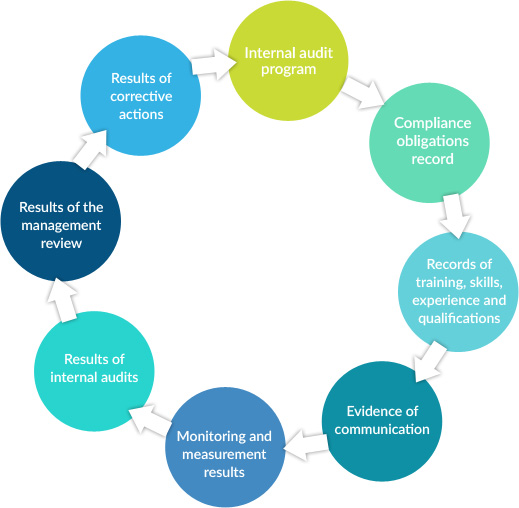WHAT IS ISO 14001?
ISO 14000 is a family of standards related to environmental management that exists to help organizations to identify, prioritize and manage environmental risks as part of normal business practices to enhance its performance. In simple terms, it is a means to highlight your organization’s commitment to environmental protection. It provides a framework that an organization can follow, rather than establishing environmental performance requirements to set up an effective EMS. ISO 14001 is voluntary, with its main aim to assist companies in continually improving their environmental performance, while complying with any applicable legislation. There are five key focus areas in the ISO 14001 standard:
Some of the major elements, which an effective EMS focuses on at an organizational level are,
- Establish a corporate environmental policy that makes strong commitments to the environment
- Understand how activities, products and services interact with and impact the environment, and identify significant impacts
- Set environmental objectives, targets and programs and manage them closely
- Determine competency requirements for persons who have the potential to cause significant environmental impacts and ensure these requirements are met and records retained
- Manage environmental documents and records to a high professional standard
- Develop operational controls in areas that have significant environmental risks
- Develop environmental emergency preparedness and response plans
- Establish a range of feedback mechanisms to update management on environmental performance and effective functioning of the system.
In many terms, ISO 14000 is similar to ISO 9000 quality management where both pertain to the process of how a product is produced, rather than to the product itself. This indeed enable Organizations that align their commercial objectives with global ecological concerns stand to gain a substantial competitive advantage. Therefore, compliance to such a standard ranks high on the agenda of thousands of organizations worldwide that place importance on their environmental impact. The mandate will still require the basic principles and existing requirements of ISO 14001:2015 in addition to improving environmentally safe outputs as part of the core management system.
WHAT IS IT BASED ON
The essential elements for ISO 14001 environmental management systems certification are that, it must commit to continual improvement and to comply with applicable regulations and legislation, the elements which will drive your organisation to continually develop your environmental performance and achieve greater recognition in the marketplace in which you operate.Both ISO 9001:2015 and ISO 14001:2015 share a common structure, terminology and framework which makes the standard very complimentary enabling an easy and seamless integration organized as a "single system" rather than two separate stand-alone systems which many organizations holding both certifications would have operated.
The major underpinning of the ISO 14001environmental management system is the ‘Plan-Do- Check-Act’ cycle which is in common with other management system standards.
PLAN: Defining Goals
Gap assessment is one factor which is highly recommended to identify all possible rudiments of business operations that influences with the Environmental Aspects. It provides the organization with a clear definition of management principles. Which helps to plan and establish environmental goals and targets, which can be built on to their policy. It is a useful tool for an organization to step up from just maintaining regulatory compliance to an organization with improved productivity and enhanced competitive advantage.
DO: System Execution
In this phase, the devised principles and processes are to be implemented by the organization to make sure that are in-line with their policy. In order to do so, it is necessary to implement resources and foster better assurance and process over the elements such as credentials control, knowledge transfer to employees, readiness and responsive during emergency situations. Above all, an effective and a vigorous part of this phase is to establish a collative participation and communication across all levels of the organizational stack up to implement an effective EMS in place.
CHECK: Process observance
Monitoring and compliance observance on a periodic basis is another important factor once the process has been implemented. It is to make sure that the environmental targets and objectives, at an organizational level, are being met. Internal audits are also a part of this phase which is conducted to make sure that the EMS is in-line with the compliance and requirements and are being adhered to.
ACT: Performance enhancement
During this stage, a management review is conducted to ensure that the objectives of the EMS are being met, the extent to which they are being met, and that communications are being appropriately managed; and to evaluate changing circumstances, such as legal requirements, in order to make recommendations for further improvement of the system.
WHO SHOULD USE IT
The ISO 14001 standard is highly flexible allowing it to be applied to the complete range of business sectors, scopes, and activities, which is one of its great benefits. Itprovides a framework through which an organisation can deliver environmental performance improvement in line with its environmental policy commitments. Similar in structure to the ISO 9000 quality management system standard, ISO 14001 outlines key requirements companies should comply with in order to operate in an environmentally responsible manner. ISO 14001 is applicable to all types and sizes of manufacturing and service operations throughout the world where it specifies environmental requirements that the organization identifies as those which it can control and influence.ISO 14001 is flexible - it is as applicable to both the small business and the multinational organization. The extent of the application depends on factors like the environmental policy of the organization, the nature of its activities, products and services, the location and the conditions in which the company functions.
It includes,
For simpler, small companies we offer our ISO 9001 and ISO 14001 Group Scheme – a simple low-cost approach to certification. This offers the best value approach to certification for smaller companies currently available. For more complex companies (multi-site, complex design processes, international trade etc.) or larger companies, we offer Training services, systems design, development and deployment, and certification.
Some of the major benefits that an organization would enthrall through the implementation of a robust environmental management system to streamline processes at an organizational level are:
- Identify cost savings, particularly in your resource, waste and energy management
- Improve efficiency and reduce environmental impact across your product life cycle
- Improve your corporate image and credibility, so helping you win new customers.
- Quantify, monitor and control the ongoing environmental impact of your operations
- Ensure your organisation understands and complies with environmental legislation, so reducing the likelihood of fines and prosecutions
- Improve the environmental performance of your supply chain
- Potentially reduce the costs of public liability insurance for your organisation
- Clearly identify leadership responsibilities and improve employee engagement through improved communications
WHAT ARE THE REQUIREMENTS
In order to get certified for ISO 14001, there are few requirements that an organization needs to fulfill during initial assessment and audit process. The documents that you need to produce if you want to be compliant with ISO 14001 are:
Mandatory records that needs to be in place are:
BENEFITS OF ISO 14001
- Customer, investor, public, community assurance by demonstrating commitment
- Improving cost control through use of energy, which also may imply a reduction in the cost of running your business.
- Providing and improving the care for the environment and achieving the intended deliverables of environmental management
- New business opportunities, as credibility from stakeholders and consumers for minimalized environmental impact, is established.
- Realizing one’s own responsibility and managing environmental responsibility in a systematic manner
- Identification, description and reduction of risks and reducing incidents that result in liability, therefore reducing insurance costs
- Improving the company’s profile/image and improving the environment
- Stakeholder and Risk management through a High Level Structure (HLS), easily integrate with more than one standard
- Fulfilling legal regulatory objectives and other environment-oriented demands of a demography.
- Gain a competitive advantage over the environmental performance throughout the supply chain.
- Early identification of problems with the environment.
- More guarantees for the compliance with legal and other requirements.
- Preventing potential problems, sanctions and expenses related to the removal of potential damages caused to the environment.
- Competitive advantages.







